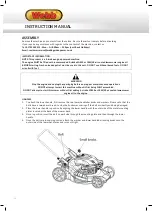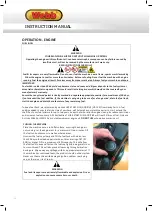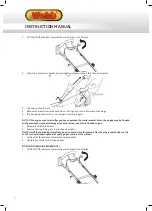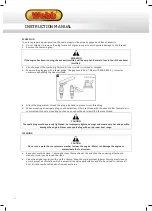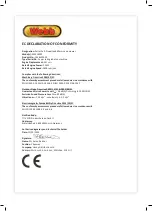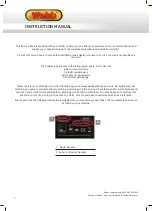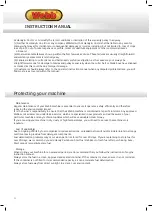
23
STORAGE & TRANSPORT
The following steps should be taken to prepare your machine for storage.
STORING THE LAWNMOWER FOR SHORT PERIODS
The lawnmower can be stored for short periods of time (less than 15 days) without performing any storage
maintenance.Before placing the lawnmower into storage always carry out the following:
1.
Allow the engine to fully cool.
2.
Ensure the grass collector is empty.
3.
Clean all debris from under the mower deck.
4.
Store the lawnmower on a flat and level surface with the mower upright.
5.
Store in a safe place which is not accessible by children or people who are not familiar with operation.
STORING THE LAWNMOWER FOR EXTENDED PERIODS
If the lawnmower is to be place into storage for more than 15 days, storage maintenance must be performed
on the lawnmower. If the following steps are not carried out, when you next operate the lawnmower it may
not start correctly and may need to be serviced.
CAUTION
Do not empty the petrol tank in enclosed areas, near fire or when smoking. Petrol fumes can cause
explosions and fire
1.
Empty the petrol tank with a petrol suction pump if available.
2.
Alternatively, start the engine and let it run until any remaining petrol has been used up.
3.
Change the oil at the end of every season. See removing oil within this manual.
4.
Clean the cooling fins of the cylinder and the housing
5.
Be sure to clean the entire machine to protect the paint.
6.
Store the machine in a well-ventilated place.
7.
Remove the spark plug. Use an oil can to fill approx. 20 ml oil into the combustion chamber. Operate the
starter to evenly distribute the oil in the combustion chamber. Replace the spark plug.
2.
Store in a dry, clean and frost-protected place, out of reach of unauthorised persons.
CAUTION
The engine must have completely cooled down before storing.
NOTE:
When storing any type of power equipment in an unventilated or material storage shed,
−
Care should be taken to rust-proof the equipment. Using a light oil or silicone, coat the equipment,
especially cables and all moving parts.
−
Be careful not to bend or kink cables.
−
If the starter rope becomes disconnected from rope guide on handle, disconnect and ground the spark
plug wire. Depress the blade control handle and pull the starter rope out from engine slowly. Slip the
starter rope into the rope guide bolt on handle.
DO NOT STORE fuel for longer than 30 days. Fuel can become stale and cause damage to the engine
carburetor, which is not covered by the machines manufacturer’s warranty.
SPARK PLUG
To ensure proper engine operation, the spark plug must be properly gapped and free of deposits.
1.
Do not attempt to remove the plug from a hot engine in order to avoid possible damage to the threads.
2.
Remove the spark plug cap.
WARNING
If the engine has been running, the exhaust (muffler) will be very hot. Be careful not to touch the exhaust
(muffler).
3.
Visually inspect the spark plug. Discard it if the insulator is cracked or chipped.
4.
Measure the plug gap with a feeler gauge. The gap should be 0.7-0.8mm (0.028-0.031 in), correct as
necessary by bending the side electrode.
5.
Attach the plug washer, thread the plug in by hand to prevent cross-threading.
6.
When mounting a new spark plug, you should screw 1/2 more thread with the wrench after the washer is
compressed. If you are mounting an old one, you should only screw 1/8-1/4 more thread.
CAUTION
The spark plug must be securely tightened. An improperly tightened plug can become very hot and possibly
damage the engine. Never use a spark plug with an improper heat range.
CLEANING
CAUTION
Do not use a water hose or pressure washer to clean the engine. Water can damage the engine or
contaminate the fuel system.
•
Keep your machine clean. Thoroughly clean the machine at the end of each use, paying attention to
stones or mud in and around the tines.
•
Clean the engine regularly with a cloth or brush. Keep the cooling system (blower housing area) clean to
permit proper air circulation which is essential to engine performance and life. Be certain to remove all
dust, dirt and combustible debris from exhaust area.


